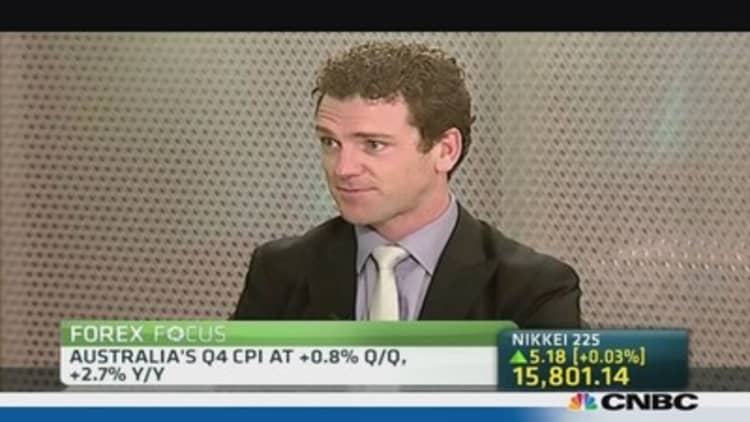A surprise spike in Australia's inflation rate will give the nation's central bankers pause for thought, analysts say, making it trickier to decide between keeping rates low to stimulate the economy and raising rates to pour cold water on frothy price rises.
Consumer prices rose 0.8 percent in the fourth quarter of 2013, taking annual inflation to 2.7 percent, at the upper end of the Reserve Bank of Australia's target of between 2 and 3 percent. Sharp increases in the price of fruit and vegetables, travel costs and tobacco were behind the overall increase.
(Read more: Has the tide turned for corporate Australia?)
slipped 0.7 percent on the news, while the Australian dollar strengthened to $0.8855 against the dollar, retreating from Monday's three-and-a-half-year low. The 15 percent fall in the Aussie over the past year has been a key factor behind rising prices, increasing the cost of imports.
Analysts told CNBC the higher-than-expected inflation number could encourage a more hawkish stance at the nation's central bank.
(Read more: 2014 a 'litmus test' for Australia economy: Goldman)

"The inflation data certainly surprised to the upside and suggests that the next rate move is going to be up," said Matthew Circosta, economist at Moody's Analytics.
"Inflation risks are on the rise as the housing market continues to be strong and the dollar is off its highs. Inflation is only going to pick up and the RBA needs to be on guard in 2014," he added.
David Greene, head of dealing at trading firm AFEX Australia, also told CNBC that the surprise rise in inflation could prompt a rate hike.
"Obviously they [the RBA] focus on a 2-3 percent band, and any upside of 3 percent may suggest some interest rate hikes, that's why the market is reacting the way it is," he said.
The RBA has cut interest rates eight times over the past two years to a record low of 2.5 percent in an effort to offset the end of its mining boom and stimulate other parts of the economy.
Last week, disappointing December jobs data, which saw Australian employers sack the most people in nine months, led some analysts to speculate that another rate cut could be in store, but Wednesday's inflation data could turn such speculation around.
(Read more: Will Australia's jobs shocker put the RBA to work?)

According to Reuters, interbank futures on Wednesday showed a 20 percent chance of a cut by July, compared with just over 50 percent before the data was released.
"This is clearly a disappointing outcome and substantially reduces the possibility of another rate cut from the RBA," said Shane Oliver, head of investment strategy and chief economist at AMP Capital.
Oliver told CNBC he did not see an imminent rate hike however.
"While the increase in inflation will concern the RBA it's not bad enough to bring on an imminent rate hike either," he said, adding that the 2.7 percent annual inflation rate was still in line with the RBA's inflation target and pointed out that excluding volatile items, like fruit and vegetables, inflation was just 0.6 percent.
AFEX Australia's Greene added that the RBA is now in a similar situation to the U.S. Federal Reserve and the Bank of England, in term of combating mixed signals from economic activity.
(Read more: Another reason why Australians are lucky)
"Certainly on that one number, a lot of people are getting excited and the RBA will be too. But it doesn't mean Australia is out of the woods," he said.
"I think central banks are a little bit confused as to where these figures are coming from but still they are mandated so they are doing what they need to," he added.
— By CNBC's Katie Holliday: Follow her on Twitter @hollidaykatie


